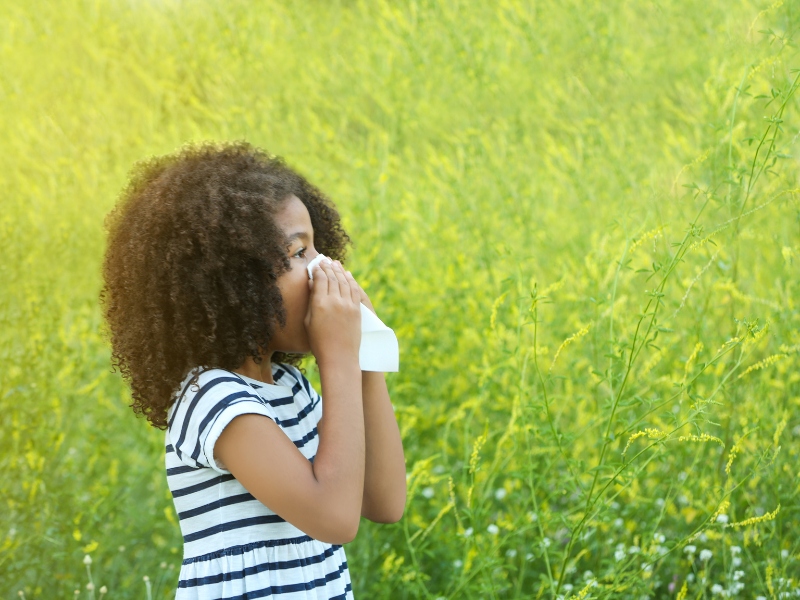Is your child sneezing and wheezing but doesn’t have a fever? Are symptoms worse after spending time outdoors?
Your child may be grappling with seasonal allergies.
According to the U.S. Centers for Disease Control and Prevention, almost 20% of children younger than 18 have seasonal allergies, with many children being diagnosed around age 4 or 5. Having allergies isn’t fun, but there are steps you can take to help your child cope before and during allergy season.
First, it’s important to understand whether your child’s symptoms are caused by allergies or a viral infection, such as a cold, flu or COVID-19.
Symptoms of seasonal allergies include:
- Runny nose with clear mucus
- Sneezing
- Itchiness, such as an itchy eyes, itchy nose or itchy throat. The roof of the mouth may also feel itchy.
- Red eyes
- Dark circles under the eyes
- Coughing
- Wheezing
Children with eczema – a skin condition characterized by intense itching, dry skin and a raised rash – may have a flare up if they also have seasonal allergies. Also, I want parents to know that asthma and allergies often go hand in hand: If a child has asthma, they may also have more asthma flares during pollen season.
If your child has a fever, colored mucus or loses their sense of taste and smell, they most likely have a viral infection. Reach out to your child’s doctor for advice on how to treat common viruses. Tests for COVID-19, flu and RSV can confirm a diagnosis.
How to Prevent Symptoms of Seasonal Allergies in Children
If your child regularly experiences seasonal allergies, you can help them make the best of allergy season. I recommend starting your child on over-the-counter medications a few weeks before the start of allergy season to allow the medications time to start working. Options include oral antihistamines, corticosteroid nasal sprays, antihistamine nasal sprays and eye drops. Your child’s pediatrician, allergist or pharmacist can help you choose the best medication for your child.
Other ways to reduce the symptoms of seasonal allergies include:
- Monitoring pollen levels using websites or apps that offer pollen forecasts. Encourage your child to play indoors if pollen levels are high.
- Keeping windows and doors closed to prevent pollen from entering your home and car. Use air conditioning or fans instead.
- Teaching your child to take off their shoes at the doorway to avoid tracking pollen throughout the house.
- Having your child change clothes when coming in from outside.
- Showering at night so pollen doesn’t accumulate in the bed.
- Checking and changing air filters throughout the house, and purchasing filters that capture allergens.
If symptoms persist despite these changes, reach out to your child’s pediatrician or allergist.
Allergy Testing in Children
Depending on the severity of your child’s symptoms, they may need to see an allergist. If the allergist recommends allergy testing, make sure your child doesn’t take any antihistamines for a few days before the testing.
When I perform allergy tests on children, I usually start with the skin prick test. It can be uncomfortable but is helpful in diagnosing allergies. I use a small device to scratch the skin on the child’s back with drops of possible allergens. I then check the skin 15 minutes later for red, raised, itchy areas. If your child has a red, raised, itchy bump at the site that is considered a positive result.
For children who can’t tolerate a skin prick test, we use a blood test instead. Results are usually available a few days later.
Allergy testing allows us to test sensitivity to a variety of substances – or allergens – including trees, grasses, weeds, molds, animals, dust, feathers and even cockroaches!
Treating Seasonal Allergies in Children
Once we identify what triggers a child’s allergies, we can start developing a treatment plan. Some children benefit from over-the-counter nasal sprays, which relieve congestion. Some children do well with oral antihistamines and/or eye drops. Many children with allergies benefit from prescription medications in combination with over-the-counter remedies.
I usually recommend against nasal or oral decongestants in children, especially in children younger than 6. In general, decongestants in children have more risks than benefits.
If children aren’t feeling better after trying over-the-counter remedies and prescription medications, we can consider allergy shots, or immunotherapy. Allergy shots are given weekly for about six to eight months, followed by monthly injections for several years. Though a significant time commitment, allergy shots are a very effective long-term solution. For many children, immunotherapy not only alleviates symptoms of seasonal allergies but changes the immune system’s response to the allergen by building tolerance to the allergen.
Parents sometimes are surprised by the severity of their child’s allergies. They also are surprised to learn that their child’s allergies may be lifelong. Working with your child’s pediatrician and allergist is vital to helping your child manage symptoms and enjoy the outdoors.
Dr. Natalia Vernon is a board-certified allergist with the Mid-Atlantic Permanente Medical Group. She sees patients at the Kaiser Permanente South Baltimore County Medical Center.

